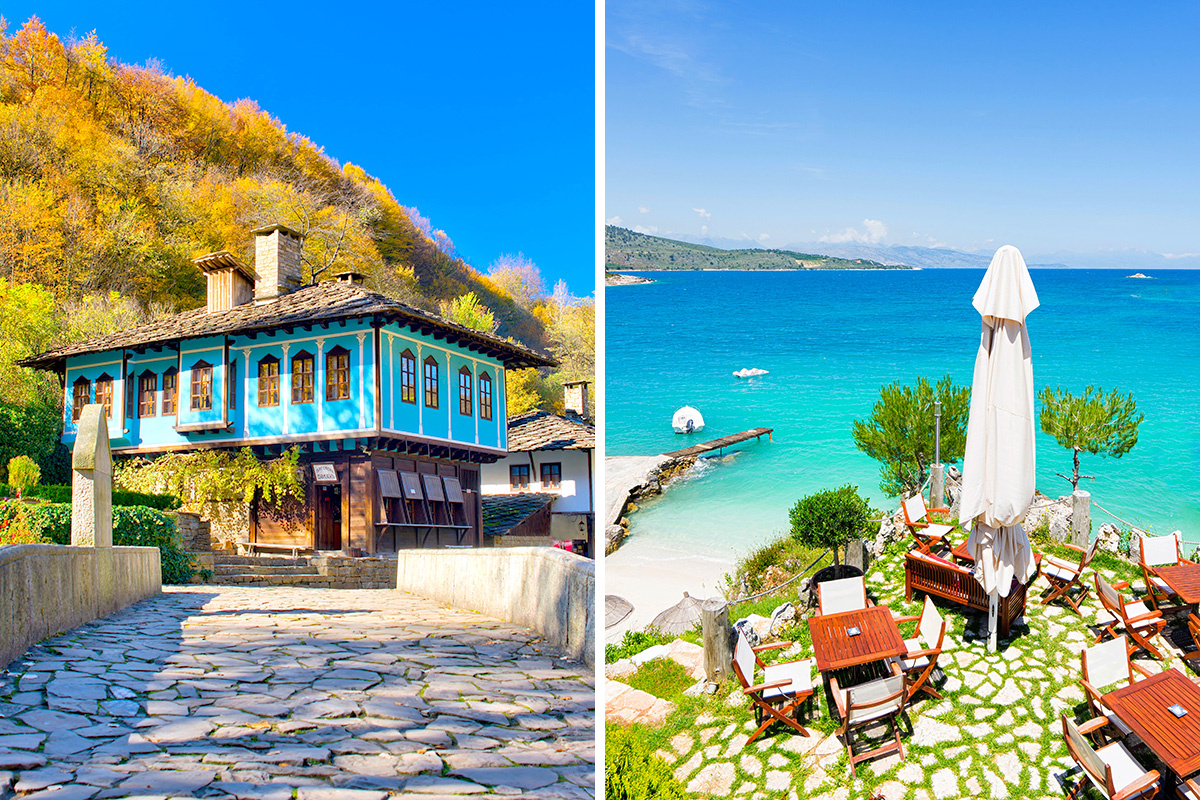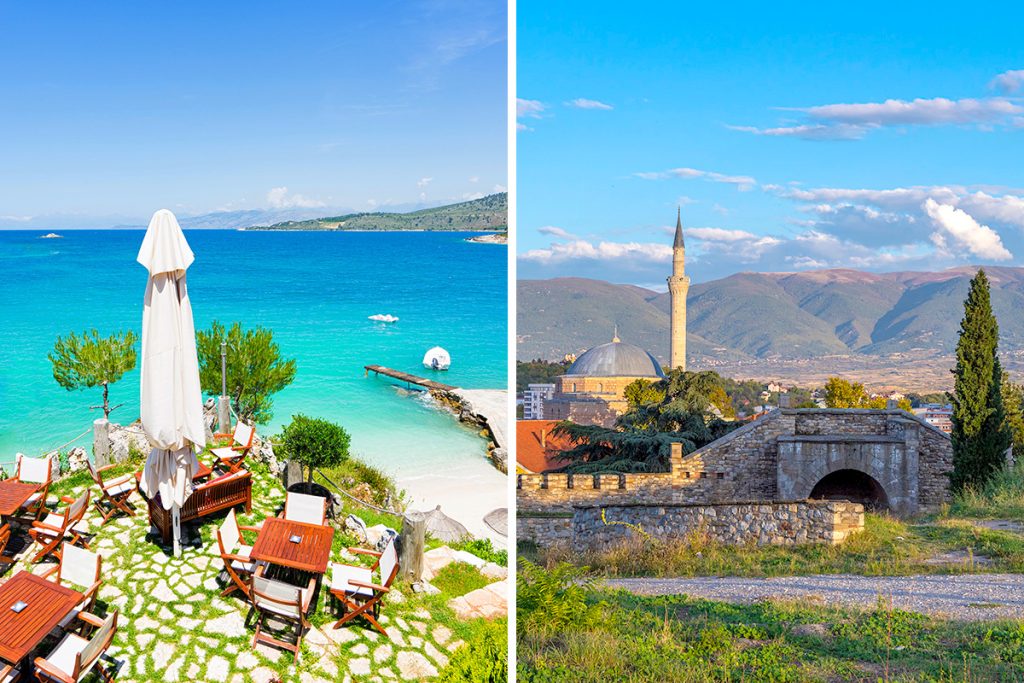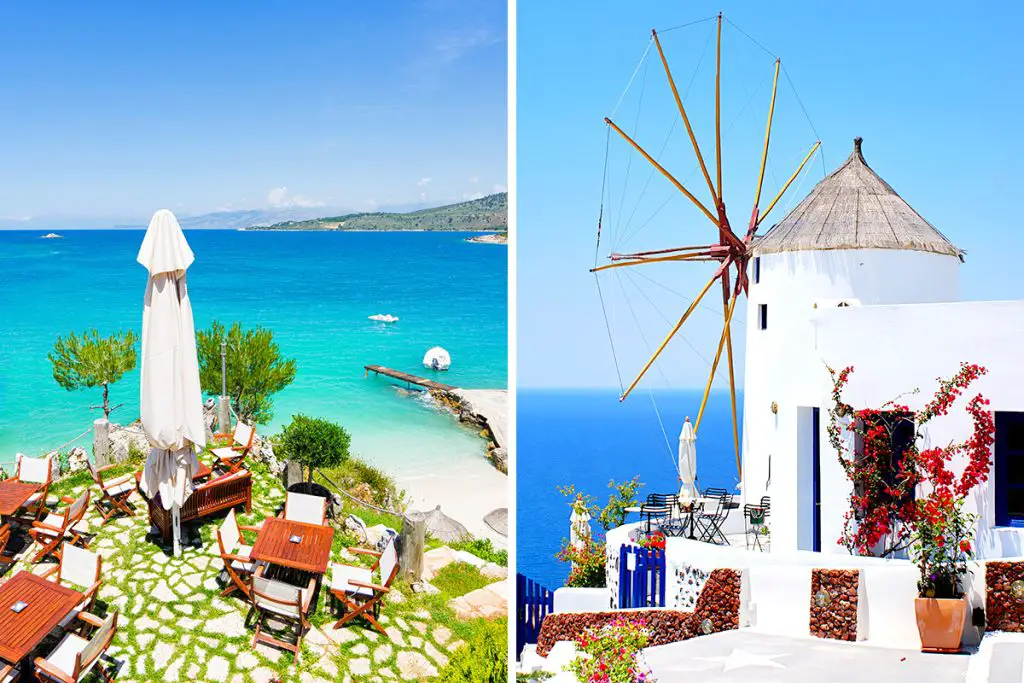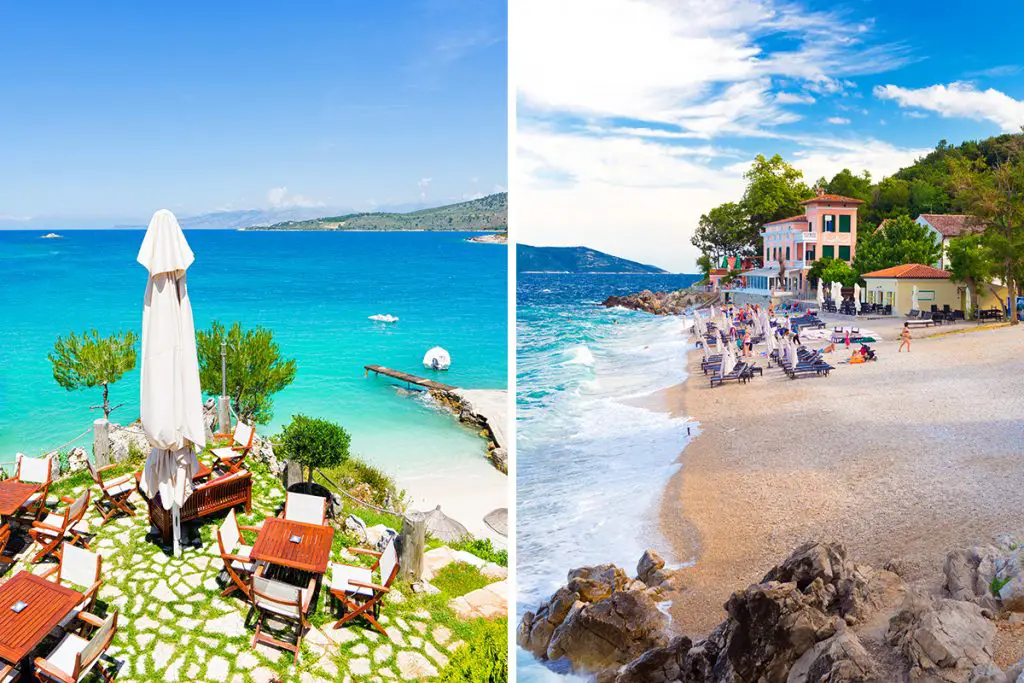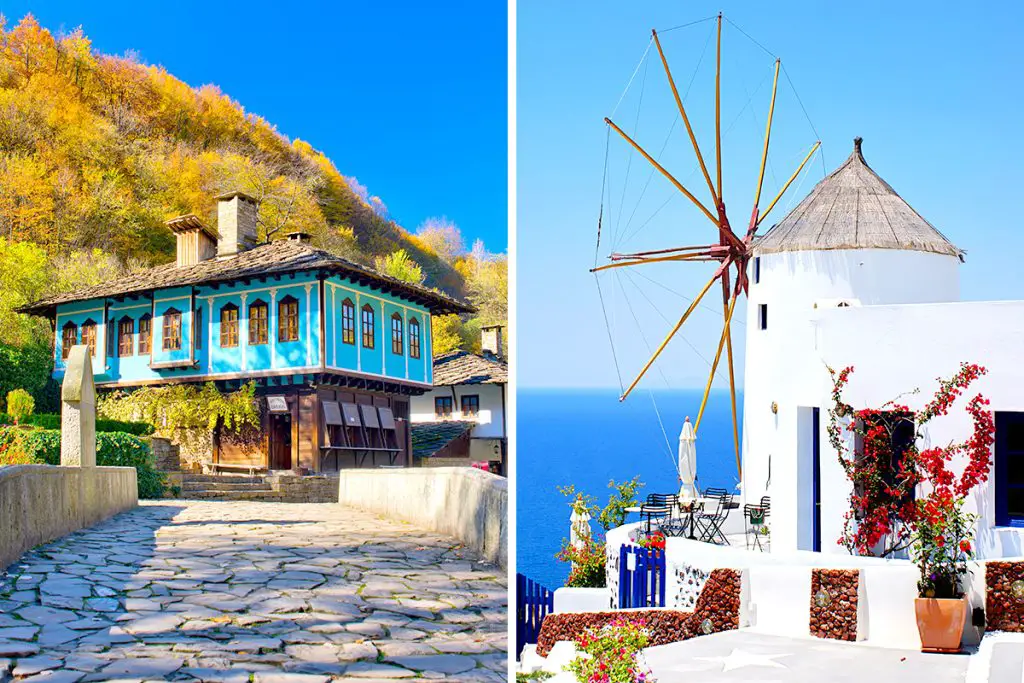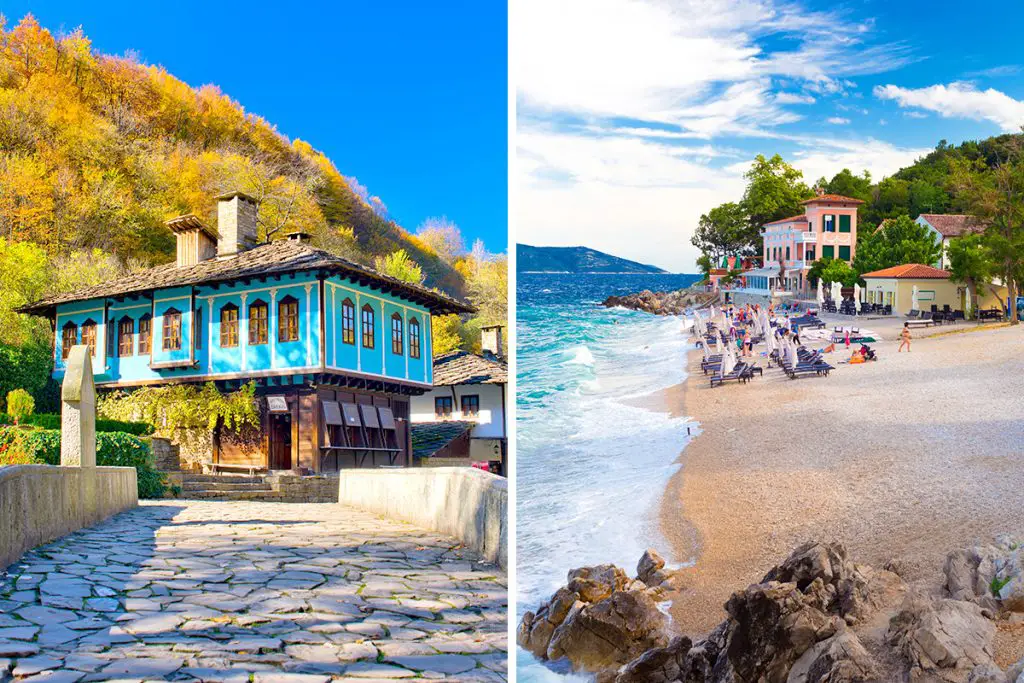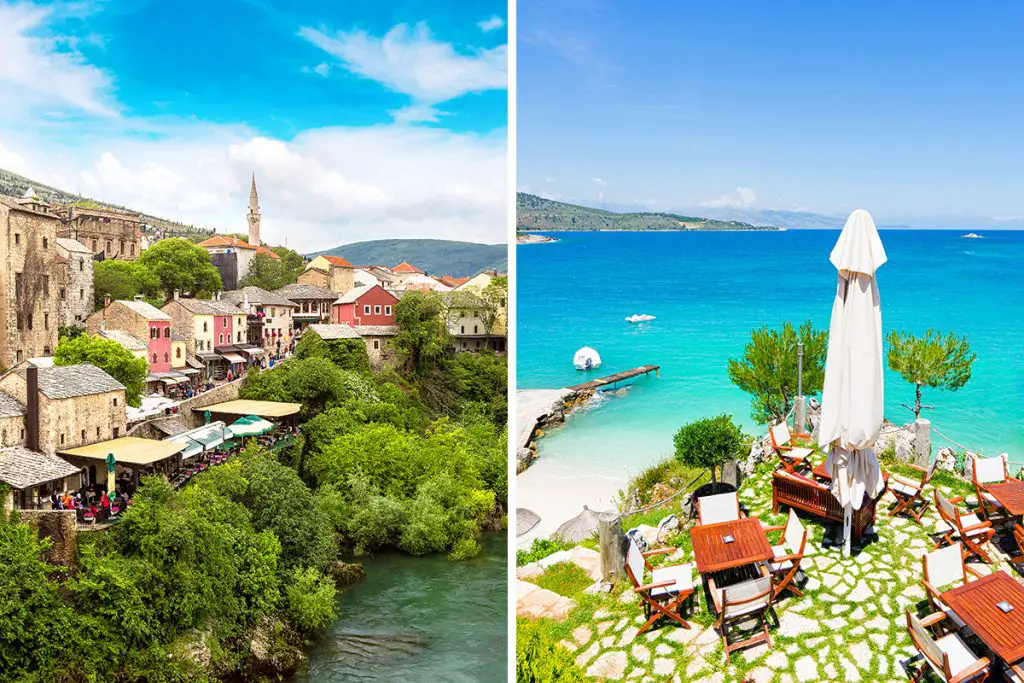The vibrant tapestry of past and present in Bulgaria and Albania offers a unique glimpse into their enduring legacies. You’ll discover a contrast yet a subtle harmony between the two. Are you ready to delve into the heart of these nations’ history and culture? Your journey into understanding Bulgaria and Albania starts here.
History & Culture
Venturing into the historical realms of Bulgaria and Albania opens up a pageant of old-world charm and contemporary vibrance. Your first step into either country is like a step back in time, yet with a modern beat that echoes in the bustling city streets.
Bulgaria’s past is a rich mosaic of influences, from Thracians and Romans to Byzantines and Ottomans. The ancient ruins and architectural marvels tell tales of a turbulent yet illustrious past. Bulgaria’s folklore dances and traditional music resonate with a sense of belonging to a bygone era yet are integral parts of today’s cultural festivities.
On the flip side, Albania’s history is a tapestry woven with threads of Illyrian, Roman, Byzantine, and Ottoman narratives. The castles and ancient ruins scattered across Albania echo the whispers of a time when valiant warriors and skilled artisans walked the land. Unlike Bulgaria, Albania has a more Mediterranean vibe that is reflected in its traditional customs and social gatherings.
While Bulgaria and Albania share a historical neighborhood, their journeys through the annals of time have carved distinct identities for them.
Bulgaria tends to preserve a more orthodox and traditional aura, encapsulating a sense of the ancient in its daily life. Albania, on the other hand, tends to embrace a more open and vivacious Mediterranean spirit, which is a bit more relaxed and festive.
Summarizing the historical and cultural journey, Bulgaria offers a more traditional and somewhat solemn reflection of the past, whereas Albania presents a lively and open-hearted embrace of its history. This contrast paints a vivid picture of how two neighbors can have such distinct identities yet share a common historical canvas. Your curiosity might now be tingling with the question: which historical and cultural ethos resonates more with your adventurous spirit?
Attractions & Activities
Embarking on a journey to explore the attractions and activities of Bulgaria and Albania can be likened to stepping into a vibrant canvas. Each stroke represents unique experiences that await your exploration. As you traverse the landscapes of these destinations, the variety of attractions and activities unfold, each telling a different story of the land’s essence.
In Bulgaria, the adventures begin amidst the rugged terrain of the mountains. The picturesque Rila Monastery, nestled in the heart of the Rila Mountains, is a serene retreat with a rich historical background. Hiking trails in Pirin National Park unravel the beauty of nature, with each step taking you closer to the heavens.
For those seeking a glimpse into the past, a visit to the ancient city of Plovdiv is a must. It’s a living museum where every stone has a story to tell.
Albania, with its contrasting landscape, offers a diverse range of activities. The historical Gjirokastër, a UNESCO World Heritage site, beckons with its well-preserved Ottoman architecture.
For the nature enthusiast, hiking through the Accursed Mountains unveils breathtaking vistas that seem to stretch endlessly. The ancient ruins of Butrint take you on a journey through various epochs, each layer revealing a different civilization.
Summing up, both Bulgaria and Albania offer a rich array of attractions and activities, each with a unique flavor. Whether it’s the calm and reflective ambiance of Bulgaria or the lively and exploratory spirit of Albania, your choices carve the path to creating unforgettable memories.
Beaches
The allure of the beaches in Bulgaria and Albania is like the soft murmur of waves calling out to every weary traveler. Each coastline has its own narrative, offering a peaceful retreat from the bustling life.
Bulgaria’s Black Sea Coast is home to serene beaches like Sunny Beach, which stretches for about 8 kilometers (around 5 miles). The gentle slope of the sea bed makes it a safe haven for relaxation. Nearby, the ancient town of Nessebar tells tales of bygone eras, adding a touch of historical intrigue to your beach excursion.
On the other hand, Albania’s coastline along the Ionian and Adriatic Seas is dotted with gem-like beaches. Dhërmi Beach, with its crystal-clear waters and pebble shores, spans about 1.5 kilometers (approximately 0.9 miles). The pristine natural surroundings make it a tranquil escape for those looking to reconnect with nature.
In summary, whether it’s the calm, historical ambiance of Bulgaria’s beaches or the pristine, natural charm of Albania’s shores, each destination holds the promise of a tranquil retreat. The gentle embrace of Bulgaria’s calm shores, or the vibrant touch of Albania’s pristine beaches, which one calls out to your heart?
Eating, Drinking & Nightlife
The cultural essence of Bulgaria and Albania is not only reflected through their historical landmarks but also vibrantly alive in their eating, drinking, and nightlife scenes. Each country has its own distinct flavor and style, offering a unique experience for every traveler.
When it comes to eating, Bulgarian cuisine is a hearty affair with a variety of stews, grilled meats, and fresh salads. Dishes like kavarma (a slow-cooked pork stew) and banitsa (a savory pastry) are not only delicious but also tell stories of the land’s rich culinary heritage.
On the other hand, Albanian cuisine is a Mediterranean delight with a strong emphasis on fresh produce. Tava Kosi (baked lamb with rice) and Byrek (a flaky pastry filled with various fillings) are must-try dishes that provide a delectable glimpse into the local food culture.
Transitioning to the drinking culture, Bulgaria boasts a long tradition of winemaking with local vineyards producing exquisite varieties like Mavrud and Melnik. Tasting these wines is like a journey through Bulgaria’s rich viticulture.
Albania, however, is known for its Raki, a strong fruit brandy that holds a special place in social gatherings. A sip of Raki is like a warm invitation to Albanian hospitality.
The nightlife in Bulgaria offers a blend of cozy bars and vibrant clubs where the rhythms of Bulgarian folk music mix with modern beats. In contrast, Albania’s nightlife is more laid-back with seaside lounges and quaint bars offering a peaceful ambiance to unwind under the stars.
In summary, whether you are a food enthusiast, a wine lover, or a night owl, both Bulgaria and Albania have a unique offering for you. The hearty Bulgarian cuisine, the Mediterranean flavors of Albania, the distinct drinking cultures, and the contrasting nightlife scenes enrich your travel experience, making every moment a cherished memory.
Shopping
The shopping experience in Bulgaria and Albania is like a treasure hunt, where every corner has a unique find waiting for you. Each marketplace is a microcosm of the country’s culture, offering a myriad of items that reflect the local crafts and traditions.
In Bulgaria, you’ll find a rich tradition of craftsmanship. The markets are filled with intricately designed ceramics, handwoven textiles, and exquisite rose oil products, a hallmark of Bulgarian craft. The bustling streets of Sofia’s shopping district offer a mix of traditional shops and modern boutiques, providing a broad spectrum of shopping delights.
On the contrary, Albania’s markets are a blend of old and new. The bazaars are filled with handmade crafts, traditional costumes, and antique pieces that tell stories of the country’s diverse heritage. Tirana’s shopping scene is an eclectic mix of modern boutiques, old bazaars, and street markets where every item has a tale to tell.
While Bulgaria offers a more traditional shopping ambiance with a focus on craftsmanship, Albania provides a lively bazaar experience filled with a diverse range of items. The shopping experience in both countries is not just about the items you buy, but also about the stories and traditions they represent.
In summary, shopping in Bulgaria and Albania is an engaging experience that goes beyond mere retail therapy. It’s about delving into the heart of each country’s culture and bringing back not just souvenirs, but memories etched in clay, fabric, and timeless crafts.
Accommodation
A comfortable place to rest is essential in making your trip to Bulgaria or Albania memorable. The accommodation options in both countries cater to a variety of preferences, ensuring every traveler finds a cozy corner.
In Bulgaria, you’ll find a range of accommodations from charming guest houses in the historic towns to modern hotels in the city centers. The traditional guest houses often reflect Bulgaria’s rich architectural heritage, providing a quaint and cozy ambiance.
If you are looking for a more contemporary setting, the urban areas offer modern hotels equipped with all the amenities for a comfortable stay.
Albania, on the other hand, showcases a blend of traditional and modern lodging options. The country’s scenic countryside is dotted with family-run guesthouses offering a personal touch to your stay. In the cities, modern hotels and apartments provide a blend of comfort and convenience, ensuring you have a pleasant stay.
The choice between traditional or modern accommodations in both Bulgaria and Albania reflects the blend of old and new that is characteristic of these Balkan nations. The hospitality is warm and welcoming, making you feel at home away from home.
In summary, whether you choose the quaint charm of Bulgaria’s traditional lodgings or the welcoming embrace of Albania’s family-run guesthouses, your stay is bound to be a pleasant experience reflecting the essence of Balkan hospitality.
Family-Friendliness & Children’s Activities
Traveling with family is an adventure filled with joy and discovery. Both Bulgaria and Albania extend a warm welcome to families, offering a range of activities that are enjoyable for children and adults alike.
Bulgaria has a treasure trove of open-air activities for families. The country’s nature parks and mountain trails are perfect for family hikes where kids can enjoy the outdoors. Additionally, interactive museums like the Regional Historical Museum in Plovdiv provide an engaging learning experience for children.
In Albania, the outdoor adventures continue with family-friendly hikes in the scenic countryside, along with exploratory visits to historical sites like the ancient ruins of Butrint. The country’s rich history provides a captivating educational backdrop for children to learn and explore.
While both countries offer a plethora of outdoor activities, Bulgaria has a slight edge with its interactive museums which provide both fun and learning experiences for children. Albania, however, encapsulates a live history lesson with its well-preserved ruins and castles.
Getting There & Getting Around
The journey to and around Bulgaria and Albania is part of the adventure. The countries, though nestled in the same region, offer different experiences in terms of accessibility and local transport.
Getting to Bulgaria is facilitated through its well-connected airports like Sofia Airport, located 10 kilometers (about 6.2 miles) from the city center. On the other hand, Albania’s main gateway is Tirana International Airport, situated 17 kilometers (around 10.6 miles) from Tirana’s city center.
Both airports have connections to major European cities making them accessible options.
Once in Bulgaria, the country’s well-organized public transportation system, including buses and trains, makes getting around relatively straightforward. In contrast, Albania’s transportation network is a bit less structured, yet the experience of hopping on a local furgon (shared minivan) adds a touch of adventure to your travel.
The ease of access and movement in Bulgaria with its organized transport system contrasts with the more adventurous and slightly unpredictable nature of getting around in Albania. Each country’s transportation experience is a reflection of its unique character.
Summarizing, whether you prefer the structured transportation network of Bulgaria or the adventurous spirit of Albania’s local transport, the journey to and around these countries is bound to add unique stories to your travel diary.
Weather
The weather plays a significant role in shaping your experiences in Bulgaria and Albania. Each country has its own climate patterns that paint the sky with different hues throughout the year.
Bulgaria experiences a continental climate, with distinct seasons. Winters (December to February) can be quite chilly with temperatures dipping to around 0°C to -5°C (32°F to 23°F), while summers (June to August) are warm and sunny with temperatures hovering between 25°C to 30°C (77°F to 86°F).
The transitional seasons of spring and autumn are mild and pleasant, making them a great time for outdoor exploration.
Albania, on the other hand, enjoys a Mediterranean climate. The winters are milder with temperatures rarely falling below 7°C (45°F), while summers are hot and dry, with temperatures often reaching up to 30°C (86°F). The shoulder seasons of spring and autumn here, too, are mild and comfortable, with fewer crowds and pleasant weather.
While both countries offer a range of weather experiences, Bulgaria has a more significant temperature variation between seasons. The choice between the warm, Mediterranean climate of Albania and the contrasting seasons of Bulgaria may sway your travel decision depending on your weather preference.
Safety
Safety is a paramount concern when traveling. Both Bulgaria and Albania have their own set of safety considerations which contribute to the overall travel experience.
Bulgaria is generally considered to be a safe country for tourists. The crime rate is relatively low and the locals are friendly and helpful. In Albania too, the level of crime is low and the people are known for their hospitality towards visitors.
Unique non-crime-related safety topics include weather conditions. For instance, Bulgaria’s winter season can bring heavy snowfall and icy conditions, necessitating proper winter gear and driving caution. On the other hand, Albania’s hot summers require precautions against heat exhaustion and dehydration.
Both countries have their own set of safety advisories, and being prepared and adhering to local guidelines enhances the travel experience. It’s always a good practice to stay informed and take necessary precautions.
Summing up, safety in both Bulgaria and Albania is well-regarded with unique weather considerations playing a part in the overall safety scenario. Your awareness and adherence to safety advisories contribute to a pleasant and secure travel experience.
Cost
Exploring the cost dynamics of Bulgaria and Albania gives insight into how your budget would fare in either destination. Each country has its own cost structure that caters to a range of budget preferences.
In Bulgaria, you may find that the cost of food, lodging, and transportation is quite reasonable. A decent meal might cost around 15 Bulgarian Lev (approximately $8), while a comfortable lodging option could be $100 per night. Transportation, especially public transit, is also relatively affordable.
Albania, on the other hand, is known for being one of the most budget-friendly countries in Europe. A hearty meal could cost around 700 Albanian Lek (roughly $7) and lodging options average $60 per night. Public transportation and other basic amenities are also quite affordable.
Both countries offer value for money, and it is hard to definitively say who stands out as being particularly budget-friendly. The cost of living is low in both, making them great destinations for budget travelers.
In conclusion, whether you are on a tight budget or looking for a more luxurious experience, both Bulgaria and Albania offer a range of options to cater to your financial preferences. Your adventure in either country can be as economical or as lavish as you desire.
Which Is Better – Bulgaria or Albania?
Embarking on a journey to either Bulgaria or Albania presents a myriad of experiences waiting to be discovered. As you ponder on which destination to choose, reflecting on the diverse aspects of each country can guide your decision.
The historical and cultural narrative of Bulgaria immerses you in a rich past where traditions continue to echo through the modern rhythm of life. On the other hand, Albania offers a lively embrace of its history, flavored with a Mediterranean zest that adds a unique color to its cultural tapestry.
When it comes to attractions and activities, the serene retreats amidst Bulgaria’s rugged terrain contrast with the adventurous spirit of Albania’s diverse landscapes. The beach experiences further differentiate the two, with Bulgaria offering a calm, historical ambiance and Albania boasting pristine, untouched shores.
The culinary journey in Bulgaria is hearty and traditional, while Albania offers a taste of the Mediterranean. As the sun sets, the nightlife in Bulgaria vibrates with a mix of folk and modern beats, unlike the laid-back evenings under the stars in Albania.
Shopping in Bulgaria is a dive into a rich tradition of craftsmanship, while the bazaars in Albania are a blend of old and new, each item telling stories of a diverse heritage. The accommodation in both countries reflects their essence, with Bulgaria offering a quaint charm and Albania a welcoming embrace.
Family-friendly activities, ease of transportation, weather, safety, and cost are other lenses through which to view these Balkan neighbors. Bulgaria stands out with its structured transportation network and contrasting seasons, whereas Albania shines with its mild Mediterranean climate. Cost-wise, it is a toss-up.
In conclusion, your choice between Bulgaria and Albania hinges on personal preferences. For a tranquil, traditional, and structured experience, Bulgaria is the ideal choice. However, if you are leaning towards a lively, adventurous, and budget-friendly escapade, Albania awaits with open arms. Each country holds a unique charm, ready to make your journey a memorable adventure.

